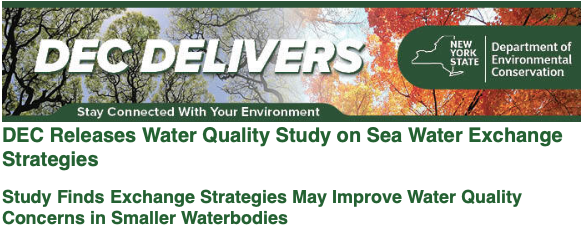
Conducted through Long Island Nitrogen Action Plan Explores Options to Improve Water Quality
April 9 Webinar to Present Study Results –
Tuesday, April 9, 2024 10:00 AM – 12:00 PM
(UTC-04:00) Eastern Time (US & Canada)
The New York State Department of Environmental Conservation (DEC) today released findings from a regional study of the impacts of exchanged sea water into Long Island embayments in an effort to improve water quality. The Long Island Nitrogen Action Plan (LINAP) Embayment Water Exchange Study explored technologies to exchange more sea water into embayments, with results showing that impacts vary depending on the type of waterbody involved. The study shows that although water exchange technologies may improve water quality in small waterbodies, these technologies do not effectively address water quality concerns in large waterbodies, which include most of Long Island’s embayments.
“New York State’s water quality experts use the latest data to ensure DEC’s policies and programs are guided by science,” said DEC Commissioner Basil Seggos. “The LINAP Embayment Water Exchange Study helped assess the effectiveness of water exchange technologies, and while these technologies may not improve water quality issues in large embayments, DEC will continue to work with our many partners across Long Island to find effective ways to restore the region’s waterways by reducing nitrogen and other harmful pollutants.”
The study looked at different types of waterbodies commonly found on Long Island, including a harbor with a sand spit, shallow harbor, open harbor, tidal stream, coastal lagoon, and coastal pond. Multiple water exchange practices were evaluated, including environmental dredging, sand spit removal, pipe-and-pump, culvert or pipe with tidal flow, and tide gates.
The results of New York’s study show that water exchange technologies do not effectively address water quality concerns in large waterbodies, which include most of Long Island’s embayments. Water exchange projects may help improve water quality in smaller Long Island waterbodies where the volume of increased water exchange approaches the volume of the overall waterbody. No actual construction of modifications was associated with the study.
DEC is holding a webinar to present the study results on Tuesday, April 9, 2024, at 10 a.m. Register for the webinar.
DEC’s project consultant created a user-friendly handbook to accompany the technical report to make the study information more accessible. The handbook also identifies other information communities should evaluate besides water quality when considering these types of water exchange projects, including cost, constructability, social acceptance, and environmental concerns beyond water quality, among others.
A link to the handbook and technical report can be found on the LINAP Embayment Water Exchange Study webpage. For more information on the LINAP, please go to the Long Island Nitrogen Action Plan (LINAP) page. The study was funded in part through a grant from the U.S. Environmental Protection Agency’s Long Island Sound Study.
“This study will help communities guide investments to restore Long Island Sound, Peconic Bay, and the south shore bays,” said EPA Regional Administrator Lisa F. Garcia. “EPA is proud to support NYSDEC and other partners as they evaluate all the options to effectively and efficiently improve the water quality of Long Island and reduce nitrogen pollution.”
In addition to the study, New York State continues to increase its nation-leading investments in water infrastructure, including $325 million in grant opportunities now open for applications at the State Environmental Facilities Corporation website. With Governor Kathy Hochul’s Executive Budget’s proposed $500 million over two years, New York will have invested a total of $5.5 billion in water infrastructure since 2017. Just last December, Governor Hochul announced $30 million to support home and small business owners with funding for more environmentally effective septic systems. The funding is in addition to other substantial water quality investments, including the voter-approved $4.2 billion Clean Water, Clean Air and Green Jobs Environmental Bond Act of 2022 which is advancing historic levels of funding to update aging water infrastructure and protect water quality, strengthen communities’ ability to withstand severe storms and flooding, reduce air pollution and lower climate-altering emissions, restore habitats, and preserve outdoor spaces and local farms.
For the complete DEC press release click on the bar below: